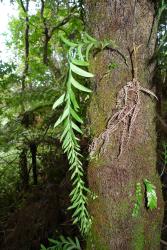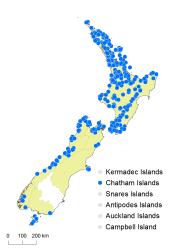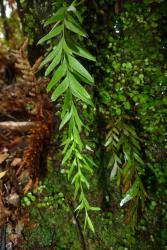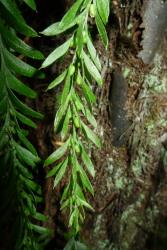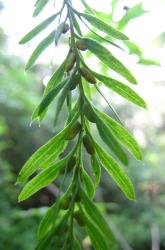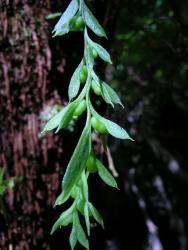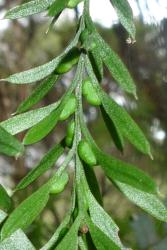- Taxon
- Gallery
- ≡ Tmesipteris tannensis var. elongata (P.A.Dang.) Domin, Biblioth. Bot. 20 (85): 231 (1915)
- = Tmesipteris lanceolata M.Sykes, Ann. Bot. (London) 22: 64 (1908) nom. illeg.
- = Tmesipteris tugana H.N.Barber, Victoria Naturalist 71: 98 (1954)
- = Tmesipteris elongata subsp. robusta Chinnock, New Zealand J. Bot. 13: 763 (1975)
Epiphytic ferns. Aerial stems pendent, 70–1400 mm long, 11–75 mm wide, unbranched or forked one to several times, of indeterminate growth eventually terminated by small sterile leaf or sporophyll. Leaves narrowly oblong to narrowly ovate, straight or falcate, spirally to almost distichously arranged, dull green on both surfaces, subcoriaceous; the longest 8–35, rarely to 45 mm long, 2–9 mm wide, at or below mid-stem; apices acuminate or cuspidate or rarely truncate, with a mucro 1–3 mm long. Sporophylls in the distal part of the stem only, or almost throughout except for the proximal part. Synangia 2.5–6 mm long, 1–2.5 mm high; lobes equal, round-ended; the lower surface of each lobe appressed to the subtending leaf margin along its length.
This is one of the two widespread species of Tmesipteris in New Zealand, recognised by its somewhat flexible leaves with acuminate or cuspidate apices, and by its round-ended synangia. Its leaves are also generally longer than in other species. It is the only species with a stem that sometimes branches more than once. Some forms are very robust, branching several times, and are much bigger than any other species in New Zealand (see below).
North Island: Northland, Auckland, Volcanic Plateau, Gisborne, Taranaki, Southern North Island.
South Island: Western Nelson, Sounds-Nelson, Marlborough, Westland, Canterbury, Fiordland, Southland.
Chatham Islands, Stewart Island.
Altitudinal range: 0-925 m.
Tmesipteris elongata occurs throughout the North Island in lowland to montane forest, and is absent only from some of the east coast. It grows from sea level in the northern North Island, up to 700 m in the Hūnua and Tararua Ranges and on Maungatautari, and to over 900 m in the Rangitoto Range near Pureora Forest. In the South Island, it occurs in coastal and lowland forest, most commonly in the Marlborough Sounds, Nelson and Westland, with isolated records in Fiordland. It grows to 400 m around Nelson and in the ranges east of Hokitika. It occurs sporadically on the east coast around Kaikoura and Banks Peninsula, where it grows to about 350 m, and in the Catlins District, but is absent from the interior of the South Island.
Also Australia (Victoria, Tasmania).
Tmesipteris elongata is found commonly as an epiphyte on tree fern trunks, recorded most frequently from Cyathea dealbata and Dicksonia squarrosa, but also occasionally from Cyathea medullaris in northern New Zealand, and Cyathea smithii at higher elevations and in the South Island. It has been recorded once from Dicksonia fibrosa on the Chatham Islands (AK 230462). It is also occasionally found growing on trunks of Beilschmiedia tawa, Dysoxylum spectabile, Hedycarya arborea, Melicytus ramiflorus, Metrosideros robusta, Nestegis spp., Fuscospora solandri, and Rhopalostylis sapida, on old rotten logs, and rarely at the base of tree trunks, on banks, or in humus. It has also been recorded once from an introduced Salix species (WAIK 4672). It occurs most frequently in a wide range of broadleaved forest but also under kauri, podocarp and beech forest and in swamp forest, or rarely under Pinus radiata.
In northern New Zealand the species can be found hanging from large clumps of Collospermum, and such plants are often much larger than those found on tree fern trunks. They were distinguished as T. elongata subsp. robusta by Chinnock (1975).
Plants have been collected from the bases of Carex secta at Lake Koraha, Matauratahi Valley (WAIK 8847), and rather stunted plants from C. secta stems in a dense Phormium tenax swamp on the south Taranaki coast (WELT P020839).
n = 104 (Brownsey & Lovis 1987).
The holotype of Dangeard’s Tmesipteris elongata has probably been destroyed (Chinnock 1975), and Dangeard’s illustration was therefore selected as lectotype (Chinnock 1998). The original localities are cited as "Terre de Van Diemen [Tasmania]; New South Wales".
Tmesipteris elongata subsp. robusta was distinguished from subsp. elongata by Chinnock (1975) primarily on the basis of its more consistently branching stem, but also by its slightly longer and broader leaves. However, it appears to overlap in all these characters with specimens of subsp. elongata, and is therefore reduced to synonymy. It is best regarded as an ecological form that grows particularly well in large clumps of Collospermum.



